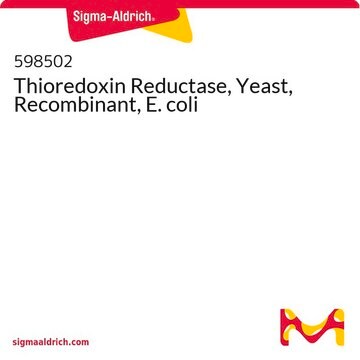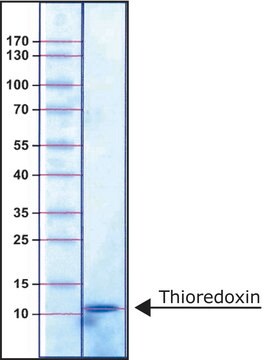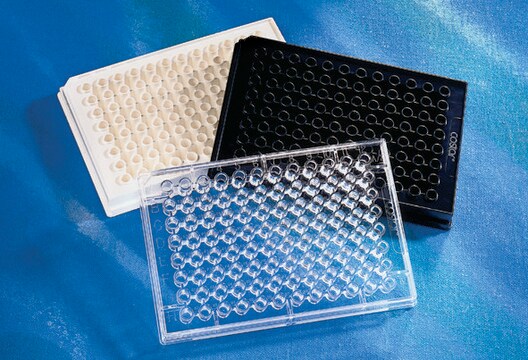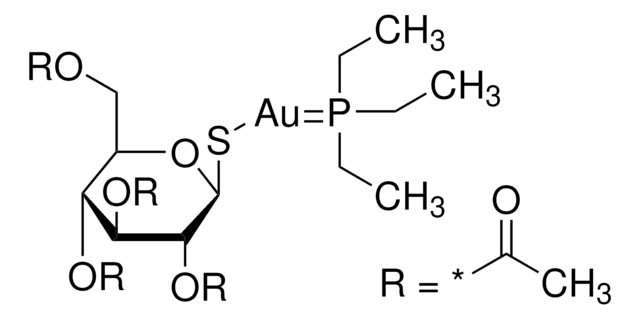CS0170
Thioredoxin Reductase Assay Kit
1 kit sufficient for 100 assays (1 mL)
Synonyme(s) :
Thioredoxin Reductase Activity Kit
Se connecterpour consulter vos tarifs contractuels et ceux de votre entreprise/organisme
About This Item
Code UNSPSC :
12161503
Nomenclature NACRES :
NA.84
Produits recommandés
Niveau de qualité
Utilisation
kit sufficient for 100 assays (1 mL)
Conditions d'expédition
dry ice
Température de stockage
−20°C
Informations sur le gène
human ... TXNRD1(7296) , TXNRD2(10587) , TXNRD3(114112)
Catégories apparentées
Description générale
The Thioredoxin Reductase Assay Kit uses a colorimetric assay for the determination of thioredoxin reductase activity in mammalian cells and tissues. It is based on the reduction of 5,5′-dithiobis(2-nitrobenzoic) acid (DTNB) with NADPH to 5-thio-2-nitrobenzoic acid (TNB) that produces a strong yellow color that is measured at 412 nm.
DTNB + NADPH + H+ ↔ 2 TNB + NADP+
DTNB + NADPH + H+ ↔ 2 TNB + NADP+
Application
Using post nuclear extracts of rat liver, the kit shows linearity up to 0.25 units per mL. In this preparation, ~20% of the activity is due to non-specific reductase activity (refractory to the TrxR inhibitor).
Caractéristiques et avantages
- An easy and simple method
- The kit contains all the reagents required for a colorimetric assay of mammalian thioredoxin reductase
- The kit includes an inhibitor solution for specific inhibition of mammalian thioredoxin reductase
- The kit has been tested with heart muscle, as well as lysates from cell lines such as HeLa, A549, Jurkat, U937, A431, COS, CHO, and NIH 3T3 cells
Composants de kit seuls
Réf. du produit
Description
- Assay Buffer 5x for Thioredoxin Reductase 30 mL
- Thioredoxin Reductase 10 μg
- Thioredoxin Reductase Inhibitor Solution .05 mL
- 5,5'-Dithiobis(2-nitrobenzoic) acid (DNTB) 150 mg
- NADPH 25 mg
- Dimethyl Sulfoxide (DMSO) 7.5 mL
Mention d'avertissement
Warning
Mentions de danger
Conseils de prudence
Classification des risques
Repr. 2
Code de la classe de stockage
10 - Combustible liquids
Point d'éclair (°F)
188.6 °F
Point d'éclair (°C)
87 °C
Certificats d'analyse (COA)
Recherchez un Certificats d'analyse (COA) en saisissant le numéro de lot du produit. Les numéros de lot figurent sur l'étiquette du produit après les mots "Lot" ou "Batch".
Déjà en possession de ce produit ?
Retrouvez la documentation relative aux produits que vous avez récemment achetés dans la Bibliothèque de documents.
Les clients ont également consulté
Matthew T Harper
Platelets, 30(1), 98-104 (2017-12-02)
Platelets are central to normal hemostasis and must be tightly controlled to prevent thrombosis. However, drug treatments that also affect platelets could lead to unwanted side effects on hemostasis or thrombosis. In this study, the effect of auranofin on platelets
Tessa D Epstein et al.
ACS infectious diseases, 5(10), 1682-1687 (2019-09-06)
Helicobacter pylori (H. pylori) infection poses a worldwide public health crisis, as chronic infection is rampant and can lead to gastric ulcers, gastritis, and gastric cancer. Unfortunately, frontline therapies cause harmful side effects and are often ineffective due to antibiotic resistance.
Francesca Magherini et al.
Oncotarget, 9(46), 28042-28068 (2018-07-03)
Au(NHC) and Au(NHC)2, i.e. a monocarbene gold(I) complex and the corresponding bis(carbene) complex, are two structurally related compounds, endowed with cytotoxic properties against several cancer cell lines. Herein, we explore the molecular and cellular mechanisms at the basis of their
Melissa A Fath et al.
Clinical cancer research : an official journal of the American Association for Cancer Research, 17(19), 6206-6217 (2011-08-17)
Cancer cells (relative to normal cells) show increased steady-state levels of hydroperoxides that are compensated by increased glucose and hydroperoxide metabolism. The current study determined whether inhibitors of glucose and hydroperoxide metabolism could induce chemoradiosensitization by enhancing oxidative stress in
Danilo Grünig Humberto da Silva et al.
Toxicology in vitro : an international journal published in association with BIBRA, 56, 62-74 (2019-01-18)
This study investigated the effects of incubation period and melatonin treatment on red blood cell (RBC) metabolism in an auto-incubation model of H2O2-induced oxidative stress. The study was carried out on three healthy adult donors by incubating RBCs in their
Notre équipe de scientifiques dispose d'une expérience dans tous les secteurs de la recherche, notamment en sciences de la vie, science des matériaux, synthèse chimique, chromatographie, analyse et dans de nombreux autres domaines..
Contacter notre Service technique












